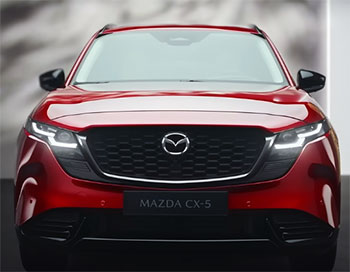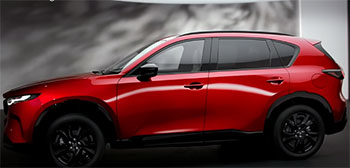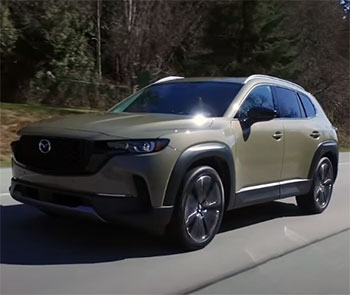I’ve always admired Mazda’s ability to craft vehicles that feel both practical and exhilarating, so when I got the chance to compare the Mazda CX-5 and CX-50, I jumped at it. My mission is to share my hands-on experience with these compact SUVs, breaking down their strengths, weaknesses, and unique vibes to help you decide which one fits your life.
Whether you’re navigating city streets or chasing weekend adventures, this article offers a detailed comparison, complete with a table, pros and cons, and answers to key questions to guide your choice.
Comparison Table: Mazda CX-5 vs. Mazda CX-50
| Feature | Mazda CX-5 | Mazda CX-50 |
|---|---|---|
| Starting MSRP | $30,265 | $31,995 |
| Base Engine | 2.5L 4-cylinder, 187 hp | 2.5L 4-cylinder, 187 hp |
| Turbo Engine | 2.5L turbo, 256 hp (93-octane) | 2.5L turbo, 256 hp (93-octane) |
| Hybrid Option | Not available | 2.5L hybrid, 219 hp |
| Fuel Economy (Base) | 26/30 MPG (City/Highway) | 25/31 MPG (City/Highway) |
| Fuel Economy (Turbo) | 22/27 MPG (City/Highway) | 23/29 MPG (City/Highway) |
| Fuel Economy (Hybrid) | N/A | 38 MPG (Combined) |
| Towing Capacity | 2,000 lbs | 3,500 lbs (turbo) |
| Ground Clearance | 7.9 inches | 8.6 inches |
| Cargo Space (Seats Up) | 29.1 cu ft | 31.4 cu ft |
| Cargo Space (Seats Down) | 59.3 cu ft | 56.3 cu ft |
| Passenger Volume | 103.6 cu ft | 100.3 cu ft |
| Infotainment Display | 10.25-inch | 10.25-inch |
| Wireless CarPlay/Android Auto | Available on higher trims | Standard |
| Bose Audio | 10-speaker (available) | 12-speaker (available) |
| Panoramic Moonroof | Not available | Available |
| Safety Rating | IIHS Top Safety Pick | IIHS Top Safety Pick+ |
My Experience With the Mazda CX-5

When I first slid into the driver’s seat of the Mazda CX-5, it felt like reuniting with an old friend.
This compact SUV, a mainstay since 2013, has a timeless appeal with its sleek, flowing lines and bold Kodo design philosophy.
I tested the Signature trim, and the exterior’s deep crystal blue mica paint gleamed under the city lights, turning heads at every stoplight.
It’s not flashy, but it exudes a quiet confidence that suits urban life perfectly.
The interior is where the CX-5 truly shines.
The Nappa leather seats were buttery soft, and the wood trim added a touch of elegance that made me feel like I was in a luxury SUV costing thousands more. I loved the small details, like the leather-like legrests on either side of the center console—perfect for resting my knees during a two-hour drive to a nearby lake.
The 10.25-inch infotainment screen was vibrant, though I was mildly annoyed that the base Preferred trim I also tested required wired Apple CarPlay. Switching to the Signature trim, with its wireless connectivity, felt like a game-changer. The 10-speaker Bose audio system transformed my daily commute into a private concert, with every bass note of my favorite indie rock playlist hitting just right.
Driving the CX-5 was a revelation. The base 2.5-liter engine, pumping out 187 horsepower, felt lively enough for zipping through city traffic. I took it on a winding mountain road, and the steering was razor-sharp, making every turn a joy.
The turbo option, with 256 horsepower on premium fuel, was a thrill for merging onto highways, though I noticed the 22/27 MPG fuel economy took a hit compared to the base’s 26/30 MPG. The suspension soaked up potholes like a champ, which was a relief on my city’s notoriously bumpy streets. I averaged about 28 MPG in mixed driving, which kept my gas budget happy.
Cargo space, however, was a mixed bag. With 29.1 cubic feet behind the rear seats, I managed to fit groceries and a couple of duffel bags, but a weekend camping trip pushed it to the limit. Folding the 40/20/40-split rear seats gave me 59.3 cubic feet, which was enough for a small mattress when I helped a friend move.
The safety suite, including adaptive cruise control and blind-spot monitoring, made me feel secure, especially when navigating rush-hour traffic. The IIHS Top Safety Pick rating backed that up.
One quirk stood out: the center console armrest was too short for my liking. As someone who sits closer to the wheel, my elbow kept sliding off, which got old fast on long drives. Still, the CX-5 felt like a refined daily driver, perfect for someone who wants a touch of luxury without the hefty price tag. It’s not built for rugged trails, but for city commutes and the occasional road trip, it’s hard to beat.
Pros Of the Mazda CX-5

- Affordable Price Point: Starting at $30,265, the CX-5 is easier on the wallet than the CX-50, offering premium features at a lower cost.
- Luxurious Interior: The Signature trim’s Nappa leather, wood accents, and legrests create a near-luxury experience that rivals pricier SUVs.
- Responsive Handling: The precise steering and well-tuned suspension make city driving and twisty roads a blast, with a sporty edge.
- Fuel Efficiency (Base Engine): At 26/30 MPG (city/highway), it’s slightly better than the CX-50, saving me money on gas.
- Generous Cargo Space (Seats Down): With 59.3 cubic feet, it outperforms the CX-50 for hauling larger items like furniture.
- Reliable Track Record: Over a decade on the market, the CX-5 has proven dependable, giving me confidence in its longevity.
- Comprehensive Safety Suite: The i-Activsense features, like lane-keep assist and adaptive cruise, plus an IIHS Top Safety Pick, ensure peace of mind.
- Quiet Cabin: The sound insulation keeps road noise at bay, making long drives serene and enjoyable.
- Flexible Rear Seats: The 40/20/40-split seats offer versatile cargo configurations, perfect for odd-shaped loads.
- Smooth Ride Quality: The independent rear suspension absorbs bumps better than the CX-50, ideal for urban streets.
The CX-5’s strengths made it a standout for me. The price was a huge draw—I could get a loaded model for less than many competitors’ base trims. The interior felt like a sanctuary; during a rainy commute, I sank into the heated seats and appreciated the quiet cabin. The handling was a highlight—parking in tight city spots was a breeze, and a weekend drive through curvy hills felt like driving a sports sedan. The fuel efficiency kept my costs down, especially on a 200-mile road trip where I hit close to 29 MPG. The cargo space saved the day when I loaded up camping chairs and a cooler, and the flexible rear seats let me fit a bike without hassle. Safety features were a lifesaver in heavy traffic; the blind-spot monitoring caught a car I missed while changing lanes. The CX-5’s reliability, backed by years of strong owner reviews, made me feel like it could be a long-term companion. It’s a polished, practical choice for anyone who values comfort and affordability.
Read More: My Thoughts On Ford Escape Vs. Mazda CX-5
Cons Of the Mazda CX-5
- No Hybrid Available: The lack of a hybrid option is a bummer for eco-conscious buyers, especially compared to the CX-50’s 38 MPG hybrid.
- Tight Cargo Space (Seats Up): Only 29.1 cubic feet behind the seats felt limiting for bulky gear like sports equipment.
- Short Armrest Design: The center console armrest is too short, leaving my elbow unsupported on long drives.
- Wired Connectivity on Base Trims: Requiring a cable for CarPlay/Android Auto feels outdated when wireless is standard elsewhere.
- Limited Towing Capacity: At 2,000 pounds, it can’t handle larger trailers, unlike the CX-50’s 3,500-pound capability.
- Lower Ground Clearance: The 7.9-inch clearance struggled on rough gravel roads, scraping slightly where the CX-50 didn’t.
- No Panoramic Moonroof: Missing this feature made the cabin feel less open compared to the CX-50’s airy design.
- Slightly Dated Styling: The design, while sleek, feels less fresh than the CX-50’s rugged, modern look.
- Base Engine Lacks Punch: The 187-hp engine is adequate but can feel underpowered when fully loaded or climbing hills.
- Smaller Rear Legroom: Taller passengers in the back complained about less legroom compared to some competitors.
The CX-5’s drawbacks became clear over my week with it. The absence of a hybrid option was a letdown, especially after seeing the CX-50’s fuel savings. Cargo space was a constant challenge; I had to Tetris my groceries to fit everything, and a stroller barely squeezed in. The short armrest was a daily annoyance—my elbow ached after a long drive. Wired CarPlay on the base trim felt like a relic, forcing me to deal with tangled cables. Towing was a non-starter; I couldn’t help a friend move a small boat, which the CX-50 could’ve handled. The lower ground clearance made me nervous on a gravel driveway, and the lack of a panoramic moonroof dimmed the cabin’s vibe. The base engine struggled when I loaded the car with passengers and luggage for a group outing. Rear legroom was tight for my 6-foot-tall friend, who felt cramped on a road trip. While the CX-5 is fantastic, these issues might push some buyers toward the CX-50.
My Experience With the Mazda CX-50

The Mazda CX-50 felt like a bold new chapter when I took it for a weeklong test.
Launched in 2023, it’s designed for adventure, with rugged fender flares and a muscular grille that screamed “take me off-road.” I drove the Premium Plus trim in Zircon Sand Metallic, and its low, wide stance drew stares at the trailhead and the coffee shop alike.
It’s a head-turner, blending toughness with Mazda’s signature elegance.
The interior struck a balance between rugged and refined. The terracotta leather seats were a standout—stylish and easy to clean after a muddy hike.
However, the hard plastic in the rear seats and cargo area felt a step down from the CX-5’s plush carpeting. The 10.25-inch infotainment system was a breeze to use, with standard wireless Apple CarPlay and Android Auto making my phone sync effortlessly.
The 12-speaker Bose system pumped out crisp sound, though I noticed the larger cabin slightly diluted the audio immersion compared to the CX-5. The panoramic moonroof, a feature the CX-5 lacks, made the cabin feel expansive, especially during a sunset drive.
Performance was where the CX-50 came alive. I tested all three powertrains: the base 187-hp engine, the 256-hp turbo, and the 219-hp hybrid. The hybrid was my favorite, offering 38 MPG combined and enough pep for highway passing.
I took the CX-50 on a light off-road trail, and its 8.6-inch ground clearance and off-road traction assist handled gravel and mud with ease. The turbo model’s 3,500-pound towing capacity let me haul a friend’s small trailer without breaking a sweat, something the CX-5 couldn’t do. However, the torsion beam rear suspension made the ride feel firmer on potholed city streets, a contrast to the CX-5’s smoother glide.
Cargo space was a win with 31.4 cubic feet behind the seats, fitting my hiking gear and a cooler easily. Folding the seats gave me 56.3 cubic feet, slightly less than the CX-5, but still ample for most needs.
The safety suite, with an IIHS Top Safety Pick+ rating, included off-road drive modes and hill descent control, which gave me confidence on a steep trail. My biggest gripe? The cupholders. My 20-ounce water bottle kept bumping the head unit, a design flaw that irritated me daily.
The CX-50 felt like a partner for adventure, equally at home on a forest trail or a city street. It’s not as plush as the CX-5, but its rugged charm and hybrid option make it a compelling choice for those who crave versatility.
Pros Of the Mazda CX-50
- Hybrid Efficiency: The 219-hp hybrid’s 38 MPG combined saved me serious cash on a 300-mile road trip.
- Robust Towing Capacity: The turbo’s 3,500-pound limit handled a small trailer effortlessly, outshining the CX-5.
- Higher Ground Clearance: At 8.6 inches, it tackled gravel trails without scraping, perfect for light off-roading.
- Bold, Rugged Design: The fender flares and chunky grille give it a distinctive, adventure-ready aesthetic.
- Wireless Connectivity Standard: Seamless Apple CarPlay and Android Auto across all trims made my life easier.
- Panoramic Moonroof: This feature, absent in the CX-5, added an open, airy feel to the cabin.
- Spacious Cargo (Seats Up): With 31.4 cubic feet, it fit my outdoor gear better than the CX-5.
- Off-Road Capability: Traction assist and drive modes made light trails a breeze, ideal for weekend escapes.
- Top Safety Rating: The IIHS Top Safety Pick+ and advanced features like hill descent control kept me secure.
- Unique Color Options: Choices like Zircon Sand Metallic added personality, making it stand out.
The CX-50’s hybrid powertrain was a revelation. On a weekend getaway, I averaged 37 MPG, cutting my fuel costs significantly. Towing a trailer for a friend’s move was stress-free, thanks to the turbo’s capability. The higher ground clearance let me explore a rocky trail without worry, and the off-road modes made it feel like a mini-Land Rover. The wireless CarPlay was a lifesaver—no cables cluttering the console. The panoramic moonroof turned a stargazing night into a magical experience, and the cargo space easily swallowed my camping gear. The rugged styling felt like an extension of my adventurous spirit, and the safety features, like cross-traffic alerts, saved me in a busy parking lot. The CX-50’s versatility made every drive exciting, whether I was in the city or the wilderness.
Cons Of the Mazda CX-50
- Higher Price Tag: Starting at $31,995, it’s pricier than the CX-5, which might stretch budgets.
- Reduced Cargo (Seats Down): With 56.3 cubic feet, it lags behind the CX-5’s 59.3 cubic feet for max storage.
- Firmer Suspension: The torsion beam rear suspension made city potholes feel harsher than the CX-5’s ride.
- Awkward Cupholder Placement: My water bottle kept hitting the head unit, a daily annoyance.
- Tighter Passenger Space: The 100.3 cubic feet of passenger volume felt less roomy than the CX-5’s 103.6.
- Cheaper Rear Materials: Hard plastic in the back seats and cargo area felt less premium than the CX-5.
- No Heated Steering Wheel (Premium Plus): Missing this feature in the top non-turbo trim was a letdown in cold weather.
- Slightly Worse Base Efficiency: The base engine’s 25/31 MPG is a hair less efficient than the CX-5.
- Louder Cabin Noise: The larger cabin let in more road noise, noticeable on highways.
- Learning Curve for Off-Road Modes: The drive mode interface wasn’t intuitive, requiring practice to master.
The CX-50’s flaws stood out during my test. The higher price made me question its value for base buyers, especially without the hybrid. The firmer ride was jarring on city streets, and I longed for the CX-5’s smoother suspension. The cupholder design was a constant irritation—my bottle’s clunk against the screen drove me nuts. The rear seats felt cramped for my taller friends, and the hard plastic back there cheapened the experience. No heated steering wheel in the Premium Plus trim was a miss during chilly mornings. The base engine’s fuel economy was slightly disappointing, and highway noise was more pronounced than in the CX-5. The off-road modes, while useful, took time to figure out, which was frustrating on a tight trail schedule. These quirks don’t ruin the CX-50, but they’re worth weighing.
Read More: My Thoughts On Acura MDX Vs. Volvo XC90
Frequently Asked Questions (FAQ)
The CX-5 is a city-focused SUV with a lower price, better base fuel economy, and more cargo space when seats are folded. The CX-50, built for adventure, offers a hybrid option, higher towing capacity, greater ground clearance, and off-road features, but it’s pricier with a firmer ride.
No, the CX-5 has more passenger volume (103.6 cu ft vs. 100.3 cu ft) and slightly more headroom and shoulder room. The CX-50 offers more cargo space with seats up (31.4 cu ft vs. 29.1 cu ft) but less when folded (56.3 cu ft vs. 59.3 cu ft).
The CX-5 lacks a hybrid, has limited cargo space with seats up, a short armrest, wired CarPlay on base trims, lower towing capacity, less ground clearance, no panoramic moonroof, dated styling, a weaker base engine, and tighter rear legroom.
Yes, the CX-50 is reliable, sharing proven engines with the CX-5 and earning strong owner feedback. Its IIHS Top Safety Pick+ rating and Mazda’s solid reputation add confidence in its dependability.
Conclusion: For Your Mazda SUV Journey
You’re at a crossroads, choosing between the Mazda CX-5 and CX-50, and I hope my deep dive into both has clarified which one aligns with your life. The CX-5 is your go-to if you’re after a refined, affordable SUV with a luxurious interior, smooth ride, and city-friendly handling. Its lower price and larger max cargo space make it a practical pick for families or urban commuters. But if you’re itching for adventure, the CX-50’s hybrid efficiency, rugged design, and off-road capabilities will fuel your wanderlust. Test drive both, feel their distinct personalities, and choose the one that makes your heart race.

